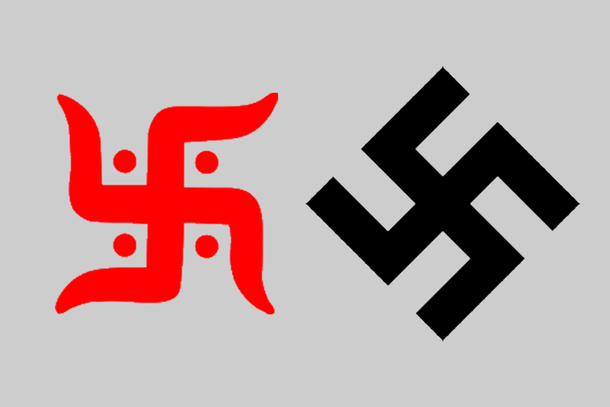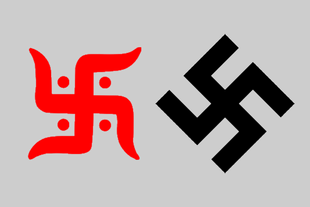Ideas
Re-Vilifying Swastika: A History Of Branding Hindu Icon As 'Symbol Of Hate'
Aravindan Neelakandan
Jul 28, 2020, 11:35 AM | Updated 11:35 AM IST
Save & read from anywhere!
Bookmark stories for easy access on any device or the Swarajya app.


Swastika controversy has come back again.
The US Senator Todd Kaminsky has sponsored the New York State Senate Bill SS6648.
The Bill is co-sponsored by Senators Joseph Addabbo Jr, Alessandra Biaggi, John E. Brooks and David Carlucci — all Democrats.
The Bill requires that students through 'the curricula for grades six through twelve' should be instructed regarding what it calls ‘symbols of hate.'
The Bill, which has already 'passed Senate’ states:
In particular, it is vital for students to be aware of the meanings of the swastika commonly exhibited as the emblem of Nazi Germany — as well as the noose — commonly exhibited as a symbol of racism and intimidation.
Already 'American Hindus Against Defamation' (AHAD), an initiative of Viswa Hindu Parishad of America (VHPA) has rightly protested against this Bill for the danger posed by the ignorance of not differentiating between the Swastika and the Nazi Hakenkreuz.
Utsav Chakrabarty, Director of Advocacy and Awareness (VHPA), had succinctly expressed the Vedic-Buddhist-Jain view of the matter thus:
We acknowledge the horrid way the swastika has been misused and misinterpreted. Even though Hitler never used the word “Swastika”, and instead used the same symbol, calling it Hakenkreuz, for the past 70 years, the Swastika continues to remain a vilified and maligned symbol. This must be corrected. Instead of censoring the symbol, we must celebrate the positive history of it. We must reclaim it from Hitler and the followers of his hateful ideology. This wrong must be righted.
Belgian Indologist Dr. Koenraad Elst has pointed out, how in 1955, when Sri Lanka and later India in 1977 demanded that they use Red Swastika in the place of Red Cross, the International Red Cross killed that ‘eminently sensible and secular proposal.’
In his book ‘Return of the Swastika: Hate and Hysteria versus Hindu Sanity’ (2007), Dr. Elst points out an important fact — that the West has been in no way ignorant of the auspicious and benign dimension of Swastika and the absolutely twisted way in which Nazis misappropriated this ancient symbol.
Elst even points out how a town in Ontario, Canada, is named ‘Swastika’.
The people there resisted the name change even during the Second World War fervour when the government wanted to name it Winston after Churchill.
The community retort was: 'To Hell with Hitler. We had the Swastika first.'
Behind the aggressive and widespread promotion of Swastika as the Nazi symbol by the West, there may be a collective guilt and transference.
The presence of Hakenkreuz in the monastery at the town of Lambach where Hitler grew has been already documented in the 2018 article 'True Indology' wrote on the 'Evangelical defamation Of Hindu symbol.'
One of Hitler's biographers, Robert Payne, points out that Hitler had mentioned his fascination with the Abbot — as a future ideal for himself.
The Abbot of Lamnach monastery, Theodorich von Hagen, who headed it during the fifties and sixties of the 19th century, had made Hakenkreuz part of his coat of arms.
Hitler could see from the window of his father's apartment the Hakenkreuz, and according to Robert Payne, it was this hooked cross of Theodorich von Hagen that ‘probably’ later became the Nazi Hakenkreuz.
There are quite a few historians who differ with regard to the Hakenkreuz of Lambach influencing Hitler’s later Nazi insignia.
It should also be remembered that apart from the intentional and mischievously wrong identification of hooked cross as Swastika, there are other symbols of hatred like the Iron Cross and the Burning Cross of the Ku Klux Klan.
The common theme that connects the hooked cross or Hakenkreuz and Iron cross of the Nazis and the burning cross of Ku Klux Klan is actually the Cross!
It is this persistent and historic resurfacing of the cross as a symbol of movements that are explicit and indefensibly intolerant and hate-filled, which makes the West shift this blame to Swastika — thus Christianity could claim deniability to the hatred that is central to the Nazi and KKK movements — the hatred which has an umbilical relation to the very core of evangelical Christian theology.
Prof. Daniel Rancour-Laferriere, Emeritus Professor of Russian University of California, Davis, in his exhaustively scholarly book 'The Sign of the Cross: From Golgotha to Genocide' (Routledge, 2017) has brought out this truth in an uncompromising manner.
He pointedly asks:
The fact is, however, the hooked cross has also been one among the various types of crosses which have been utilised by Christians within the specifically Christian context. Why, then, call it a “swastika” when dealing with this context? In particular, why risk offending Hindus, Buddhists, and some other groups by utilising their term, especially “after Auschwitz?” Why not recognise the Nazi Hakenkreuz for the Christian word and the Christian image that it is? The most accurate and culturally applicable translation of this term in post-Holocaust English is hooked cross.Daniel Rancour-Laferriere, The Sign of the Cross, Taylor & Francis, 2017 [Kindle]
Prof. Rancour-Laferriere also argues against the Christian apologetic stand that the hooked cross predates Christianity, pointing out that even the other Christian crosses predate Christianity, but that fact does not make them non-Christian objects.
The professor points out further that Hitler himself, in a speech made in 1930, said that the hooked cross as Nazi party symbol was ‘a political expression of his goal to unite the two major Christian confessions (Catholicism and Protestantism) within Germany. It was a continuation of what the Christian cross represented, namely, the “struggle” against the Jews.’
The most important aspect of the problem comes after the Holocaust and how Christendom was reacting towards its responsibility for this crime against humanity. Prof. Rancour-Laferriere explains:
The cross as a sign of victory over death was co-opted by Christian political and military leaders in order to promote another kind of victory, namely, military victory in wars against non-Christian and even against Christian enemies. The Crusades, for example, were “wars of the cross.” Muslims, Jews, heretics, pagans, and various others were attacked by military forces under the sign of the Christian cross. The Holocaust is the latest and most thoroughly victorious war won against those perceived as enemies of the cross (six million Jews are counted among the victims). The cross in this case was the hooked cross, which has been utilized continuously in Christian iconography since pre-Constantinian Christians included it along with other crosses (equilateral Greek cross, chi-rho cross) in the catacombs of Rome. The Nazi hooked cross was not a Hindu “swastika,” for the Roman Catholic dictator, and failed artist Adolf Hitler probably created it on the basis of the hooked crosses he had observed in his childhood while studying in the Benedictine monastery of Lambach. Given the long history of persecution and violence associated with the Christian sign of the cross, educated Christians face a serious psychological hindrance to the expression of reverence for the chief symbol of their own faith.
So what is the solution? The Christian discourse invented a solution that would at once cleanse Christian monopolistic theology of any guilt even as making Holocaust an added weapon against one of the most important remaining enemies of Christianity — Hindu family of religions — the last battlefield where Christianity fights against ‘paganism’.
By constantly calling the hooked cross as Swastika, Christendom has successfully put the blame for Nazi Antisemitism on Paganism.
By extension, it has also implicated Hindu Dharma. So when the children learn ‘Swastika’ and not ‘Hooked cross’ as the hate symbol, simultaneously, they will also learn about ‘Aryan invasion of India’ and also about the racial interpretation of so-called caste system in India.
Thus, the students will be convinced that Hinduism is somehow similar to Nazism.
And when the student comes out of the school and in case decides to learn Indology, she will also learn from Sheldon Pollock’s masterly woven yet false thesis that Indian Vedic religion somehow through German Indology did an internal colonization of Germany and that the Nazi movement was either the result of it or/and benefitted from it.
This will completely sanitize the immense continuity of Christian antisemitism.
There are times when offence is the best form of defence.
Hindus should not only ask for the removal of the term Swastika and introduction of the true name hooked cross as the symbol of hatred, but more importantly, teach wherever they could that it is monopolistic- expansionist theological components like the ‘the only saviour’, ‘redemption solely through the wine transformed to blood’ and ‘eternal hell’ et cetera — which are the true breeding grounds of hatred and intolerance.
Aravindan is a contributing editor at Swarajya.





